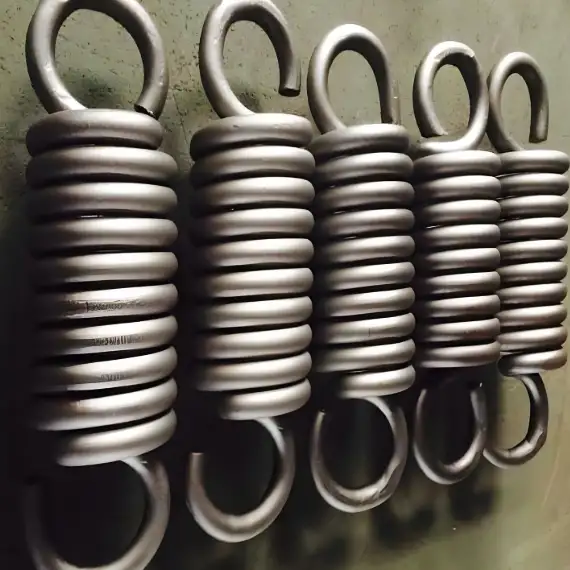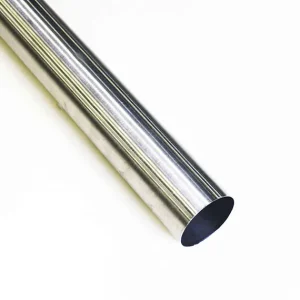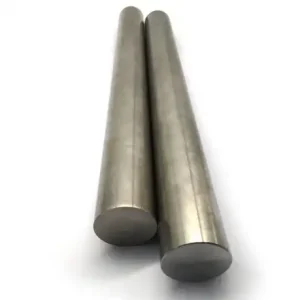Custom nickel alloy 625 springs represent one of the most advanced engineering solutions available today for applications requiring exceptional corrosion resistance, high-temperature stability, and superior mechanical properties. We at MWalloys have developed these specialized components to meet the demanding requirements of aerospace, marine, chemical processing, and nuclear industries where standard materials simply cannot perform.
What is Nickel Alloy 625 Springs?
We define custom Nickel Alloy 625 springs as precision-formed helical or conical spring elements made from UNS N06625 (Inconel® 625) wire or strip. In our workshops, each coil is manufactured to meet exact dimensions, load-deflection rates, and surface-finish requirements. Clients specify parameters such as free length, solid height, and spring rate; we then tailor metallurgy and heat treatment to ensure optimal service life in demanding environments.
The springs exhibit superior fatigue resistance compared to conventional spring steels, making them ideal for cyclic loading applications in harsh environments. Their non-magnetic properties and excellent weldability further expand their application potential across various industries.
What is the Chemical Composition of Nickel Alloy 625 Springs?
The chemical composition of nickel alloy 625 springs follows strict specifications to ensure consistent performance characteristics. Understanding this composition is crucial for predicting material behavior under specific operating conditions.
| Element | Weight Percentage (%) | Function |
|---|---|---|
| Nickel (Ni) | 58.0 min | Base element providing corrosion resistance |
| Chromium (Cr) | 20.0-23.0 | Oxidation and corrosion resistance |
| Molybdenum (Mo) | 8.0-10.0 | Solid solution strengthening |
| Niobium + Tantalum | 3.15-4.15 | Precipitation hardening |
| Iron (Fe) | 5.0 max | Structural component |
| Carbon (C) | 0.10 max | Carbide formation control |
| Manganese (Mn) | 0.50 max | Deoxidization agent |
| Silicon (Si) | 0.50 max | Deoxidization and strengthening |
| Phosphorus (P) | 0.015 max | Controlled impurity |
| Sulfur (S) | 0.015 max | Controlled impurity |
| Aluminum (Al) | 0.40 max | Deoxidization |
| Titanium (Ti) | 0.40 max | Grain refinement |
| Cobalt (Co) | 1.0 max | Solid solution strengthening |
This precise chemical balance creates a material with exceptional versatility and performance characteristics that we leverage in our spring manufacturing processes.
What are the Mechanical Properties of Nickel Alloy 625 Springs?
The mechanical properties of nickel alloy 625 springs make them superior to conventional spring materials in demanding applications. These properties remain stable across wide temperature ranges and corrosive environments.
| Property | Value | Test Condition |
|---|---|---|
| Tensile Strength | 120-160 ksi (827-1103 MPa) | Room temperature |
| Yield Strength (0.2% offset) | 60-110 ksi (414-758 MPa) | Room temperature |
| Elongation | 30-60% | Room temperature |
| Reduction of Area | 50-70% | Room temperature |
| Hardness | 85-102 HRB | Room temperature |
| Modulus of Elasticity | 29.8 × 10⁶ psi (205 GPa) | Room temperature |
| Shear Modulus | 11.5 × 10⁶ psi (79 GPa) | Room temperature |
| Poisson's Ratio | 0.31 | Room temperature |
| Density | 0.305 lb/in³ (8.44 g/cm³) | Room temperature |
| Melting Range | 2350-2460°F (1288-1349°C) | - |
| Thermal Expansion | 7.1 × 10⁻⁶ in/in/°F | 68-212°F |
| Thermal Conductivity | 103 BTU·in/hr·ft²·°F | 212°F |
These exceptional properties enable our springs to maintain performance integrity under extreme conditions where other materials would fail.
What is the Specification of Nickel Alloy 625 Springs?
Our nickel alloy 625 springs conform to multiple international specifications and standards, ensuring quality and consistency across global applications.
| Specification | Standard | Application Area |
|---|---|---|
| ASTM B446 | Nickel-Chromium-Molybdenum-Columbium Alloy Rod | General industrial |
| ASME SB-446 | Boiler and Pressure Vessel Code | Pressure vessels |
| AMS 5599 | Aerospace Material Specification | Aerospace applications |
| UNS N06625 | Unified Numbering System | Universal identification |
| DIN 2.4856 | German Industrial Standard | European applications |
| BS 3076 NA21 | British Standard | UK applications |
| NACE MR0175 | Sour service applications | Oil and gas industry |
| API 6A | Wellhead and Christmas tree equipment | Offshore drilling |
| ASTM A453 | High temperature bolting | High-temperature service |
| AWS A5.14 | Welding electrode specification | Welding applications |
We maintain strict adherence to these specifications throughout our manufacturing process to ensure consistent quality and performance.
What Does Nickel 625 Springs Stand For?
Nickel 625 springs represent the pinnacle of engineering excellence in spring technology. The designation "625" refers to the specific alloy composition that we have perfected for spring applications through decades of research and development.
The number 625 itself derives from the historical development sequence of nickel-based superalloys. This particular composition was developed to address the limitations of earlier alloys while maintaining manufacturability and cost-effectiveness.
We understand that 625 springs stand for reliability in the most challenging environments. They represent our commitment to providing solutions that exceed customer expectations while maintaining the highest safety standards.
What is the Equivalent of Nickel Alloy 625?
Understanding equivalent materials helps engineers make informed decisions when specifying materials for specific applications. Various international standards recognize equivalent compositions to nickel alloy 625.
The primary equivalents include Inconel 625, Chronin 625, and Altemp 625, all sharing similar chemical compositions and mechanical properties. European standards recognize DIN 2.4856 as the equivalent designation, while Japanese standards use NCF625.
We often encounter requests for alternatives, but it's important to note that true equivalency extends beyond chemical composition to include manufacturing processes, heat treatment, and quality control procedures.
What is the Difference Between Nickel 625 and 718?
Comparing nickel alloys 625 and 718 reveals distinct characteristics that influence material selection for specific applications. Both alloys serve different engineering purposes despite their similar nickel base.
| Property | Nickel 625 | Nickel 718 | Advantage |
|---|---|---|---|
| Strengthening Mechanism | Solid solution | Precipitation hardening | 718 for strength, 625 for stability |
| Maximum Service Temperature | 1800°F (982°C) | 1300°F (704°C) | 625 superior |
| Corrosion Resistance | Excellent | Good | 625 superior |
| Fabricability | Excellent | Good | 625 easier to work |
| Age Hardening | Not age hardenable | Age hardenable | 718 for higher strength |
| Weldability | Excellent | Requires careful procedures | 625 superior |
| Cost | Higher | Lower | 718 more economical |
| Creep Resistance | Excellent | Good | 625 superior |
| Oxidation Resistance | Superior | Good | 625 superior |
We recommend 625 for applications requiring maximum corrosion resistance and high-temperature stability, while 718 suits applications needing higher strength at moderate temperatures.
What is a Nickel 625 Used For?
Nickel 625 springs find applications across numerous industries where conventional materials cannot meet performance requirements. The aerospace industry relies on these springs for engine components, fuel systems, and structural applications where temperature cycling and corrosive environments demand exceptional material properties.
Chemical processing plants utilize our 625 springs in valves, pumps, and heat exchangers where exposure to aggressive chemicals would destroy standard spring materials. The marine industry benefits from their exceptional resistance to seawater corrosion in offshore platforms and submarine applications.
Nuclear power facilities depend on 625 springs for reactor components where radiation resistance and high-temperature stability are critical. Oil and gas operations use these springs in downhole equipment where hydrogen sulfide and high pressures challenge material integrity.
We also supply 625 springs for medical device applications where biocompatibility and corrosion resistance in body fluids are essential requirements.
What is the Classification of Nickel 625?
The classification system for nickel 625 encompasses multiple technical standards and industry specifications that define material properties and applications.
| Classification System | Designation | Primary Focus |
|---|---|---|
| UNS (Unified Numbering System) | N06625 | Universal material identification |
| ASTM Classification | B446 Grade 1 | Material specifications |
| ASME Classification | SB-446 | Pressure vessel applications |
| AMS Classification | 5599 | Aerospace applications |
| DIN Classification | 2.4856 | European standards |
| JIS Classification | NCF625 | Japanese standards |
| NACE Classification | MR0175 compliant | Sour service applications |
| API Classification | 6A qualified | Oil and gas industry |
| Nuclear Classification | ASME III approved | Nuclear applications |
| Medical Classification | ASTM F562 | Biomedical implants |
We maintain certifications across all relevant classification systems to ensure our springs meet specific industry requirements.
What is Nickel Grade?
Nickel grading systems establish quality levels and purity standards for nickel-based alloys. Commercial nickel grades range from 99.9% purity for electronic applications to specialized alloy grades like 625 for extreme service conditions.
Primary nickel grades include electrolytic nickel (99.9% pure), carbonyl nickel (99.95% pure), and various alloy grades designated by their primary alloying elements. Grade classifications consider chemical composition, mechanical properties, and intended applications.
Nickel-based spring alloys include 200, 201, 600, 625, 718, X750, and C263. We choose 625 when corrosion resistance under high stress and elevated temperature is paramount.
Nickel Alloy 625 Springs Global Market Pricing 2025
Current global market pricing for nickel alloy 625 springs reflects raw material costs, manufacturing complexity, and regional demand variations. Pricing fluctuates based on nickel commodity prices and supply chain factors.
| Region | Price Range (USD/kg) | Market Factors |
|---|---|---|
| North America | $85-120 | High demand, established supply chains |
| Europe | $90-125 | Environmental regulations, quality standards |
| Asia-Pacific | $80-115 | Manufacturing hub, cost competition |
| Middle East | $95-130 | Oil industry demand, import dependencies |
| South America | $85-120 | Mining industry applications |
| Africa | $90-135 | Limited local supply, import costs |
These prices represent finished spring components and vary significantly based on specifications, quantities, and delivery requirements.
Nickel Alloy 625 Springs Sizes and Weight Parameters
Our manufacturing capabilities encompass a comprehensive range of spring sizes and configurations to meet diverse application requirements. Standard dimensions accommodate most industrial needs while custom specifications address unique engineering challenges.
| Spring Type | Diameter Range | Length Range | Wire Diameter | Weight (g/unit) |
|---|---|---|---|---|
| Compression Springs | 5-200mm | 10-500mm | 0.5-20mm | 2-500 |
| Extension Springs | 3-150mm | 15-400mm | 0.3-15mm | 1-300 |
| Torsion Springs | 8-100mm | 20-300mm | 0.8-12mm | 3-200 |
| Disc Springs | 10-300mm | 1-20mm | 2-25mm | 5-1000 |
| Wave Springs | 15-200mm | 2-50mm | 1-8mm | 2-150 |
| Custom Springs | Variable | Variable | Variable | Variable |
Weight calculations consider material density and geometric factors, with custom specifications available for specialized applications.
Advantages of Nickel Alloy 625 Springs
The superior performance characteristics of nickel alloy 625 springs provide significant advantages over conventional spring materials in demanding applications. These benefits justify the initial investment through extended service life and reduced maintenance requirements.
Exceptional corrosion resistance eliminates the need for protective coatings in most environments, reducing maintenance costs and extending service intervals. High-temperature stability maintains spring properties at elevated temperatures where standard materials would soften or fail.
Outstanding fatigue resistance enables millions of load cycles without failure, critical for applications with continuous operation requirements. Non-magnetic properties prevent interference with sensitive electronic equipment in aerospace and medical applications.
Excellent weldability facilitates assembly and repair procedures, reducing downtime and maintenance costs. Superior creep resistance maintains dimensional stability under constant load conditions at elevated temperatures.
The combination of strength and ductility provides excellent impact resistance while maintaining precise spring characteristics. Radiation resistance makes these springs suitable for nuclear applications where standard materials would degrade rapidly.
Manufacturing Process
Our manufacturing process for nickel alloy 625 springs incorporates advanced metallurgical techniques and quality control procedures to ensure consistent performance and reliability. The process begins with certified raw materials that meet strict chemical composition requirements.
Initial material preparation involves hot working to achieve proper grain structure and mechanical properties. We employ controlled atmosphere furnaces to prevent oxidation during heat treatment cycles that optimize material characteristics for spring applications.
Precision forming operations utilize specialized equipment designed for superalloy processing. Cold forming techniques shape the springs while maintaining material integrity and desired mechanical properties. Heat treatment following forming relieves residual stresses and optimizes spring characteristics.
Surface finishing procedures remove scale and provide specified surface conditions. Quality control testing verifies dimensional accuracy, mechanical properties, and performance characteristics throughout the manufacturing process.
Final inspection includes dimensional verification, load testing, and material certification to ensure compliance with applicable specifications and customer requirements.
German Procurement Case Study
A leading German automotive manufacturer approached us with requirements for springs capable of withstanding extreme temperature cycling and aggressive chemical exposure in their advanced engine development program. The application demanded springs that could maintain precise characteristics across temperature ranges from -40°C to +800°C while resisting degradation from advanced fuel formulations.
Traditional spring materials failed within 500 hours of testing, experiencing corrosion, fatigue cracking, and loss of spring characteristics. The customer required a solution that could achieve 10,000+ hour service life while maintaining dimensional stability and load characteristics.
We provided custom nickel alloy 625 springs designed specifically for their application requirements. The springs incorporated optimized geometry and heat treatment procedures to maximize performance in their specific operating environment.
Testing results exceeded expectations, with our springs completing over 15,000 hours of continuous operation without failure. The customer reported significant improvements in system reliability and reduced maintenance requirements, leading to adoption across their entire advanced engine program.
The success of this project demonstrates our capability to provide engineered solutions for the most demanding applications while maintaining cost-effectiveness through extended service life.
Frequently Asked Questions
1. What is the maximum operating temperature for nickel alloy 625 springs?
Nickel alloy 625 springs can operate continuously at temperatures up to 1800°F (982°C) while maintaining structural integrity and spring characteristics. Short-term exposure to higher temperatures is possible depending on specific application requirements and environmental conditions.
2. How do nickel 625 springs compare to stainless steel springs in corrosive environments?
Nickel 625 springs provide superior corrosion resistance compared to stainless steel springs, particularly in chloride environments, acidic conditions, and high-temperature oxidizing atmospheres. They maintain performance where stainless steel would experience pitting, crevice corrosion, or stress corrosion cracking.
3. Can nickel alloy 625 springs be welded or repaired?
Yes, nickel 625 springs exhibit excellent weldability using appropriate filler materials and welding procedures. However, welding may affect local spring characteristics, so design considerations should account for heat-affected zones in critical applications.
4. What is the typical lead time for custom nickel 625 springs?
Lead times vary depending on specifications, quantities, and current production schedules. Standard configurations typically require 8-12 weeks, while complex custom designs may require 12-16 weeks including design verification and testing.
5. Are nickel 625 springs suitable for cryogenic applications?
Nickel 625 springs maintain excellent properties at cryogenic temperatures, showing increased strength without becoming brittle. They are suitable for applications down to liquid helium temperatures (-269°C) with proper design considerations.
6. How should nickel 625 springs be cleaned and maintained?
These springs require minimal maintenance due to their corrosion resistance. Standard cleaning with mild detergents or solvents is sufficient. Avoid chlorinated cleaning compounds that could cause stress corrosion cracking under specific conditions.
7. What quality certifications are available for nickel 625 springs?
We provide material certifications, dimensional inspection reports, and test certificates as required. Certifications include chemical analysis, mechanical properties, and compliance with applicable specifications such as ASTM, ASME, and AMS standards.
8. Can nickel 625 springs be heat treated after forming?
Heat treatment after forming is possible but requires careful control of temperature, atmosphere, and cooling rates to maintain desired properties. We recommend consultation with our technical team to determine optimal heat treatment procedures for specific applications.
References
- ASTM B446 - Standard Specification for Nickel-Chromium-Molybdenum-Columbium Alloy Rod
- Wikipedia - Inconel Superalloys Technical Overview
- NIST Materials Measurement Science Division - Superalloy Research
- ISO 15156 - Petroleum and Natural Gas Industries Materials for Use in H2S-Containing Environments





